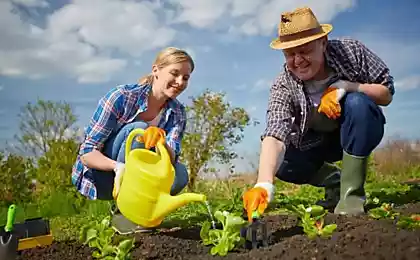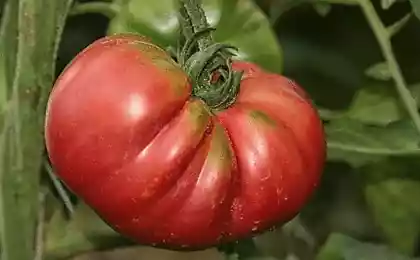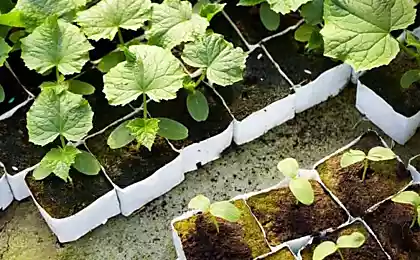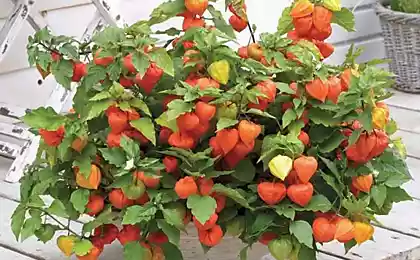743
When to sow vegetable seedlings
Approaching a responsible and long-awaited for many gardeners it's time: very soon the windowsills of city apartments will turn into a mini-plantation of seedlings of peppers, tomatoes, flowers. And one of the most important decisions that you will make at this time the gardener-gardener — timing of sowing.
Experienced growers-fans usually there are already time tested answers to the question: "When to plant?" Beginners dug up piles of magazines and books, sometimes getting conflicting information. Meanwhile, the market for new types of vegetable crops and new varieties of familiar — and all we want to try to grow. And the new plants are the new dates. How to calculate them? I want to find a universal formula, right? Well, let's try!
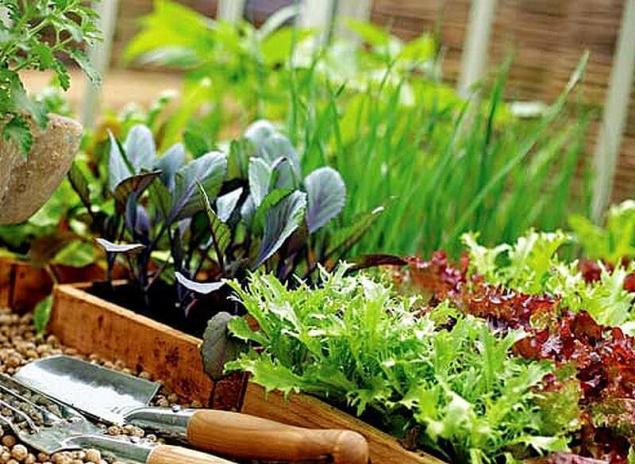
Elements of the formula
Optimum sowing time to the seedling even for the same culture may vary considerably, so for example, I am very skeptical of the General recommendations of the type "to sow tomatoes need 1 to March 10". Universal sowing time, in my opinion, calling is almost impossible — too many individual factors define it. But it can be calculated with great accuracy.
For this we need to know:
The length of the growing season
It is about time that elapses from the moment of germination until the plants and harvest. Naturally, the length of this period from different cultures are different, and the ones that have a long growing season, we usually grown seedling method — otherwise, in our latitudes, they simply will not have time to give harvest.
In addition, different duration of vegetation period of different varieties of the same plant. On this basis allocate early-ripening, mid-ripening and late-ripening varieties. It is clear that late-more time is required for the formation of yield than the early maturing, and, naturally, we have to take this into account when determining with time of sowing.
On the seed packet specifies the duration of the vegetative period in days — it is something we need. Well, for reference you can remember that "average" data on the most popular vegetable crops:
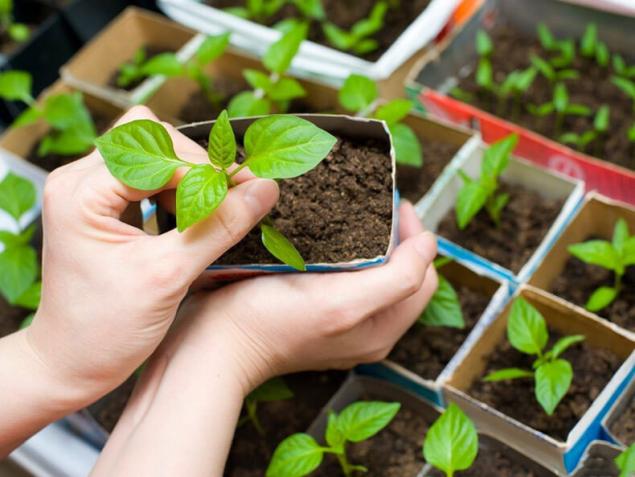
Optimum age of seedlings
For picking, transplanting, seedling and planting it in the ground every culture has its own optimal age — it is at this time the young seedlings are the easiest to tolerate traumatic procedure, take root faster and get sick less. Accordingly, it is necessary therefore to choose the time of sowing to planting the seedlings had reached the appropriate age.
Result for benchmark recommended by experts age of vegetable seedlings for planting in the ground:
Requirements of plants to heat
Most vegetable crops that we grow seedling method, it is very thermophilic. The exception is, perhaps, only cabbage that tolerates a relatively low temperature. Why it is important for us? Because this figure, in the end, will affect the time of transplanting in the ground.
For example, if the eggplant — exclusively heat-loving vegetable, hurry to landing (even under cover), we will not — wait until pass the probability of late frosts. But some of the new varieties of tomato and pepper bred by breeders for the Northern regions are low (for their culture, of course) the requirements for heat. Frost could not bear, but with good shelter they can be planted in the country, and early thermophilic counterparts.
Just specify accurate numbers as "early," you will not name. Moreover, the weather is increasingly unpredictable: in the winter rain, it may snow)) But to take into account this parameter, under other equal conditions, still stands.
Growing conditions
This is one of the most important variables in our formula: the landing of plants in greenhouses and in open ground, as a rule, the timing differs substantially. So, for tomatoes, for example, the estimated time of transplanting in summer (not heated) greenhouses in the suburbs — the beginning of may, and in the open ground the first week of June, when left behind all possibility of frost. Of course, in the first case we can pick the crops in February and the second before the end of March better not to start.
Don't forget: shelter shelter is also different. And if possible planting in the open ground are determined mainly climatic and weather conditions, planting seedlings in a greenhouse or a greenhouse largely depends on your ability. What exactly is your greenhouse? Than it is covered? If it heated? Can you in case of an unexpected cold snap additionally to cover the plants? For these and many other questions knows the answer only the grower. And because the date and time specified in your favorite magazine or website, you will need to adjust on your own — taking into account the existing conditions.
The desired time of harvest
Yes, this option is very relative: no matter how much we wanted to in the country in Central crop of tomatoes in may, perhaps, fail)), Then what is its significance? It's simple: by changing (within reasonable limits) sowing the seeds for seedlings, we influence the time of harvest, and thus making the crops in several stages, can prolong the fruiting period.
Want extra-early crop? Select the early maturing varieties and sow their seedlings as early as possible — given other conditions, of course. Sow in a few sentences — will receive uneven-aged seedlings, which will begin to bear fruit at different times. However, to land it too will have step by step — it should be considered.
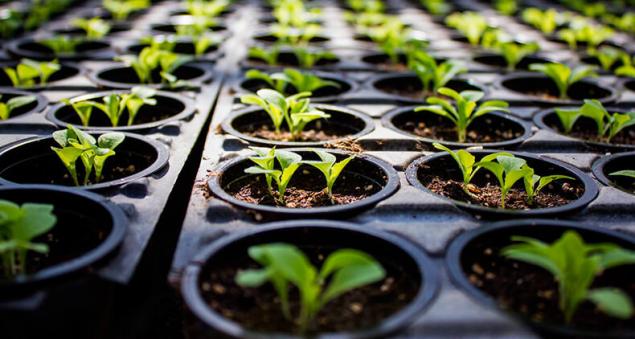
The period of seed germination
That's what this "stuff" in the calculations is often overlooked. Meanwhile, some vegetables period from sowing to germination can be 10-15 days, and it will agree, is not enough!
When doing calculations, always take into account that the period of seed germination can vary even for the same culture. And it depends not necessarily on the quality of the seeds, but also by soil temperature, moisture, depth of seeding — that is, conditions that we have created them.
Seed treatment with certain drugs (such as immunotsitofit or zircon) can speed up germination and make it more friendly. Different appear the seedlings from dry and pre-wetted seeds. In short, there are nuances. But orientirueshsya we, of course, again on average for the selected culture:
This factor is key: in our formula it will become a point of reference. And to navigate the easiest, in my opinion, the scheme proposed by the author of the Living Organic system of Agriculture V. I. Kuznetsov. The basis of his calculation method is based on two basic terms:
But there are objective criteria by which to determine exactly what time it is.
The term "COLD"
It is determined by the soil temperature and humidity and, more specifically, physical ripeness.
If in the daytime soil temperature at a depth of 8 cm reaches 8 degrees, this is enough for crops. How to define? Using a conventional thermometer and the small blade. Dig a hole and measure the temperature of the soil.
There is no desire or ability to dig? An indirect indication that the soil temperature reached the desired level, are blossoming on the first birch leaves. If you are at this time working with the land, its cold you can still feel, but the hand did not get cold.
Another important factor is the physical ripeness of the soil, ready for sowing. How is it determined? Simple: take a handful of soil, squeeze in the fist and drop a ball from a height of about 1 meter, and then evaluate the results:
The term "HEAT"
It is determined by the ending date of the most recent, the last spring frost. How would you know? Of course, the weather and weather reports to help us. And yet — people's signs and weather observations. So, Kuznetsov refers to the words of his friend and colleague, agronomist with 50 years of experience, V. I., Kornilova: "This is the time when chick-Svorcik looks out from his house, and fades last Kalina, when the swallows have arrived — summer has begun".
The number of warm days
In the system of V. Kuznetsova is another interesting calculation of the indicator: the number of frost-free days. It helps to define, whether you need General, seedlings of a particular culture, or you can sow directly into the soil in a suitable time frame.
About the length of the vegetation period we have already talked about. And it is clear that plant so that it can grow from seed to harvest, you will need the heat — especially if we are talking about such heat-loving sissy like the eggplant or pepper. Accordingly, if the number of frost-free days at your latitude is markedly longer than the duration of the vegetative period of the selected culture, seedlings do not need to plant so enough time even when planting directly into the ground.
Unfortunately, the climate in most of our regions on this opportunity can not be expected, therefore, we occupy the early spring home window sills numerous seedlings. But to calculate interest the number of frost-free days in your area, it is not difficult: forecast date of the first autumn frosts subtract the term "HEAT". Sample data for different latitudes is given in table 2.

Go to calculation
So, all components of our universal formula is. What to do with them next?
1. On the basis of their climatic conditions, we choose approximate date of transplanting (you can use the table №1). Depending on the conditions of cultivation, as a starting point we can take the term "CHILL" (greenhouses and polytunnels) or period of "HEAT" (open ground).
2. From that date subtract the optimum age of seedlings of the selected culture. Do not forget to take into account the length of the growing season specified on the bag of seeds, and, if necessary, adjust the resulting interval.
3. From the calculated date, we subtract the period of seed germination — we get approximate dates of sowing.
This basic calculation, we can clarify and Supplement. For example, depending on the desired time of harvest to choose (within their capabilities) multiple sowing. Or a bit shift (earlier or later side) approximate date of transplanting, depending on the requirements to heat, which makes the selected culture. But who is planting and sowing according to the lunar calendar, will choose from possible dates of sowing one that best accords with the movement of the moon.
One thing is important: take it slow. After all, overgrown, sown too early the seedlings will not, contrary to expectations, early and high yields. So is it worth to torture plants and suffer yourself? Has anyone tried to get early seedlings, knows that it's not just the light even a little, heat is also not enough, and efforts for cultivation requires much more!
Example of calculation
For example, let's consider the calculation of specific data. For example, let's calculate when to sow seedlings tomato varieties 'Moskvich' in a median strip for planting in the open ground.
1. Despite the fact that this variety of tomato is considered to be resistant to low temperatures, landing in open ground should not start earlier term "HEAT". For the Middle band (the latitude of Moscow) is approximately 10 June (see table 1).
2. 'Moskvich' — early maturing variety, the duration of its vegetation period is 90-105 days, so the optimum age of seedlings for planting in the ground is 40-50 days. Subtract from date of transplanting this term — we get the period from 20 April to 1 may.
Check yourself: based on the duration of the vegetation period (90-105 days), this variety of tomato when transplanting at the age of 40-50 days, it will take another 50 to 65 days to form a full harvest. The number of frost-free days in the Middle zone approximately 90 (see table 2), which means that plants in the open ground will be able to grow and please us. Although we understand, of course, that August cold and late blight can significantly reduce this time — but that's another story))
3. Tomato seeds germinate in an average of about 5 days. Subtract them from the received time — get tentative dates of sowing: 15-25 April.
Which is better: wood or briquettes
What flowers to plant seedlings in January
As you can see, it really is not that bad. But perhaps you still have questions? Or do you not agree? Each of us has his own experience, and if you have something to share, by all means write about it in the comments. The only correct one for all recipe still does not exist, and each uses the information. But I will be very happy if my tips will be useful to you. All successful crops and healthy, strong seedlings! published
Author: Marina Gerasimenko
Source: vk.com/wall-124849355?offset=160&own=1&w=wall-124849355_954
Experienced growers-fans usually there are already time tested answers to the question: "When to plant?" Beginners dug up piles of magazines and books, sometimes getting conflicting information. Meanwhile, the market for new types of vegetable crops and new varieties of familiar — and all we want to try to grow. And the new plants are the new dates. How to calculate them? I want to find a universal formula, right? Well, let's try!

Elements of the formula
Optimum sowing time to the seedling even for the same culture may vary considerably, so for example, I am very skeptical of the General recommendations of the type "to sow tomatoes need 1 to March 10". Universal sowing time, in my opinion, calling is almost impossible — too many individual factors define it. But it can be calculated with great accuracy.
For this we need to know:
- the length of the growing season for specific crops;
- the optimal for this plant is the age of the seedlings when planting in the ground;
- requirements of a plant to heat;
- growing conditions (greenhouse, greenhouse, outdoor);
- the desired time of harvest;
- the period of seed germination;
- the climatic conditions of your region.
The length of the growing season
It is about time that elapses from the moment of germination until the plants and harvest. Naturally, the length of this period from different cultures are different, and the ones that have a long growing season, we usually grown seedling method — otherwise, in our latitudes, they simply will not have time to give harvest.
In addition, different duration of vegetation period of different varieties of the same plant. On this basis allocate early-ripening, mid-ripening and late-ripening varieties. It is clear that late-more time is required for the formation of yield than the early maturing, and, naturally, we have to take this into account when determining with time of sowing.
On the seed packet specifies the duration of the vegetative period in days — it is something we need. Well, for reference you can remember that "average" data on the most popular vegetable crops:
- tomatoes — from 80 to 140 days;
- sweet pepper from 90 to 140 days;
- eggplant — from 100 to 150 days;
- cabbage — 50 (ultra-early) to 190 (late) days.

Optimum age of seedlings
For picking, transplanting, seedling and planting it in the ground every culture has its own optimal age — it is at this time the young seedlings are the easiest to tolerate traumatic procedure, take root faster and get sick less. Accordingly, it is necessary therefore to choose the time of sowing to planting the seedlings had reached the appropriate age.
Result for benchmark recommended by experts age of vegetable seedlings for planting in the ground:
- early maturing tomatoes — 40 to 50 days;
- tomatoes the mid — 55-60 days;
- the tomato late-ripening — in 70 days;
- sweet pepper — 50-65 days;
- eggplant — 45-60 days.
Requirements of plants to heat
Most vegetable crops that we grow seedling method, it is very thermophilic. The exception is, perhaps, only cabbage that tolerates a relatively low temperature. Why it is important for us? Because this figure, in the end, will affect the time of transplanting in the ground.
For example, if the eggplant — exclusively heat-loving vegetable, hurry to landing (even under cover), we will not — wait until pass the probability of late frosts. But some of the new varieties of tomato and pepper bred by breeders for the Northern regions are low (for their culture, of course) the requirements for heat. Frost could not bear, but with good shelter they can be planted in the country, and early thermophilic counterparts.
Just specify accurate numbers as "early," you will not name. Moreover, the weather is increasingly unpredictable: in the winter rain, it may snow)) But to take into account this parameter, under other equal conditions, still stands.
Growing conditions
This is one of the most important variables in our formula: the landing of plants in greenhouses and in open ground, as a rule, the timing differs substantially. So, for tomatoes, for example, the estimated time of transplanting in summer (not heated) greenhouses in the suburbs — the beginning of may, and in the open ground the first week of June, when left behind all possibility of frost. Of course, in the first case we can pick the crops in February and the second before the end of March better not to start.
Don't forget: shelter shelter is also different. And if possible planting in the open ground are determined mainly climatic and weather conditions, planting seedlings in a greenhouse or a greenhouse largely depends on your ability. What exactly is your greenhouse? Than it is covered? If it heated? Can you in case of an unexpected cold snap additionally to cover the plants? For these and many other questions knows the answer only the grower. And because the date and time specified in your favorite magazine or website, you will need to adjust on your own — taking into account the existing conditions.
The desired time of harvest
Yes, this option is very relative: no matter how much we wanted to in the country in Central crop of tomatoes in may, perhaps, fail)), Then what is its significance? It's simple: by changing (within reasonable limits) sowing the seeds for seedlings, we influence the time of harvest, and thus making the crops in several stages, can prolong the fruiting period.
Want extra-early crop? Select the early maturing varieties and sow their seedlings as early as possible — given other conditions, of course. Sow in a few sentences — will receive uneven-aged seedlings, which will begin to bear fruit at different times. However, to land it too will have step by step — it should be considered.

The period of seed germination
That's what this "stuff" in the calculations is often overlooked. Meanwhile, some vegetables period from sowing to germination can be 10-15 days, and it will agree, is not enough!
When doing calculations, always take into account that the period of seed germination can vary even for the same culture. And it depends not necessarily on the quality of the seeds, but also by soil temperature, moisture, depth of seeding — that is, conditions that we have created them.
Seed treatment with certain drugs (such as immunotsitofit or zircon) can speed up germination and make it more friendly. Different appear the seedlings from dry and pre-wetted seeds. In short, there are nuances. But orientirueshsya we, of course, again on average for the selected culture:
- tomatoes — 4-6 days;
- sweet pepper — 12-15 days;
- eggplants — 8-10 days;
- cabbage — 4-5 days.
This factor is key: in our formula it will become a point of reference. And to navigate the easiest, in my opinion, the scheme proposed by the author of the Living Organic system of Agriculture V. I. Kuznetsov. The basis of his calculation method is based on two basic terms:
- the term "COLD" or cold period of sowing — time, when in the open ground cold-resistant culture are sown and seedlings planted early maturing cabbage, and in the closed ground (greenhouses) it is possible to plant seedlings of heat-loving tomatoes, peppers, eggplants, cucumbers;
- the term "HEAT" or warm period of sowing is a time of sowing and planting in the open ground seedlings of heat-loving crops.
But there are objective criteria by which to determine exactly what time it is.
The term "COLD"
It is determined by the soil temperature and humidity and, more specifically, physical ripeness.
If in the daytime soil temperature at a depth of 8 cm reaches 8 degrees, this is enough for crops. How to define? Using a conventional thermometer and the small blade. Dig a hole and measure the temperature of the soil.
There is no desire or ability to dig? An indirect indication that the soil temperature reached the desired level, are blossoming on the first birch leaves. If you are at this time working with the land, its cold you can still feel, but the hand did not get cold.
Another important factor is the physical ripeness of the soil, ready for sowing. How is it determined? Simple: take a handful of soil, squeeze in the fist and drop a ball from a height of about 1 meter, and then evaluate the results:
- a lump formed, but the fall does not work — the soil is too wet, do not hurry with the crops and plantings;
- the lump is not formed, the soil crumbles in hand — the time lost, the spring soil moisture is gone, and before planting will require watering;
- a lump is formed, and when the drop is falling apart — the soil has reached the ideal level of physical maturity, it's time to sow.
The term "HEAT"
It is determined by the ending date of the most recent, the last spring frost. How would you know? Of course, the weather and weather reports to help us. And yet — people's signs and weather observations. So, Kuznetsov refers to the words of his friend and colleague, agronomist with 50 years of experience, V. I., Kornilova: "This is the time when chick-Svorcik looks out from his house, and fades last Kalina, when the swallows have arrived — summer has begun".
The number of warm days
In the system of V. Kuznetsova is another interesting calculation of the indicator: the number of frost-free days. It helps to define, whether you need General, seedlings of a particular culture, or you can sow directly into the soil in a suitable time frame.
About the length of the vegetation period we have already talked about. And it is clear that plant so that it can grow from seed to harvest, you will need the heat — especially if we are talking about such heat-loving sissy like the eggplant or pepper. Accordingly, if the number of frost-free days at your latitude is markedly longer than the duration of the vegetative period of the selected culture, seedlings do not need to plant so enough time even when planting directly into the ground.
Unfortunately, the climate in most of our regions on this opportunity can not be expected, therefore, we occupy the early spring home window sills numerous seedlings. But to calculate interest the number of frost-free days in your area, it is not difficult: forecast date of the first autumn frosts subtract the term "HEAT". Sample data for different latitudes is given in table 2.

Go to calculation
So, all components of our universal formula is. What to do with them next?
1. On the basis of their climatic conditions, we choose approximate date of transplanting (you can use the table №1). Depending on the conditions of cultivation, as a starting point we can take the term "CHILL" (greenhouses and polytunnels) or period of "HEAT" (open ground).
2. From that date subtract the optimum age of seedlings of the selected culture. Do not forget to take into account the length of the growing season specified on the bag of seeds, and, if necessary, adjust the resulting interval.
3. From the calculated date, we subtract the period of seed germination — we get approximate dates of sowing.
This basic calculation, we can clarify and Supplement. For example, depending on the desired time of harvest to choose (within their capabilities) multiple sowing. Or a bit shift (earlier or later side) approximate date of transplanting, depending on the requirements to heat, which makes the selected culture. But who is planting and sowing according to the lunar calendar, will choose from possible dates of sowing one that best accords with the movement of the moon.
One thing is important: take it slow. After all, overgrown, sown too early the seedlings will not, contrary to expectations, early and high yields. So is it worth to torture plants and suffer yourself? Has anyone tried to get early seedlings, knows that it's not just the light even a little, heat is also not enough, and efforts for cultivation requires much more!
Example of calculation
For example, let's consider the calculation of specific data. For example, let's calculate when to sow seedlings tomato varieties 'Moskvich' in a median strip for planting in the open ground.
1. Despite the fact that this variety of tomato is considered to be resistant to low temperatures, landing in open ground should not start earlier term "HEAT". For the Middle band (the latitude of Moscow) is approximately 10 June (see table 1).
2. 'Moskvich' — early maturing variety, the duration of its vegetation period is 90-105 days, so the optimum age of seedlings for planting in the ground is 40-50 days. Subtract from date of transplanting this term — we get the period from 20 April to 1 may.
Check yourself: based on the duration of the vegetation period (90-105 days), this variety of tomato when transplanting at the age of 40-50 days, it will take another 50 to 65 days to form a full harvest. The number of frost-free days in the Middle zone approximately 90 (see table 2), which means that plants in the open ground will be able to grow and please us. Although we understand, of course, that August cold and late blight can significantly reduce this time — but that's another story))
3. Tomato seeds germinate in an average of about 5 days. Subtract them from the received time — get tentative dates of sowing: 15-25 April.
Which is better: wood or briquettes
What flowers to plant seedlings in January
As you can see, it really is not that bad. But perhaps you still have questions? Or do you not agree? Each of us has his own experience, and if you have something to share, by all means write about it in the comments. The only correct one for all recipe still does not exist, and each uses the information. But I will be very happy if my tips will be useful to you. All successful crops and healthy, strong seedlings! published
Author: Marina Gerasimenko
Source: vk.com/wall-124849355?offset=160&own=1&w=wall-124849355_954

